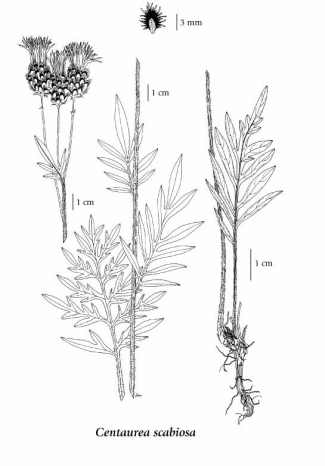Centaurea scabiosa L.
greater centaurea (greater knapweed)
Asteraceae (Aster family)
Introduction to Vascular Plants
greater centaurea (greater knapweed)
Asteraceae (Aster family)
Introduction to Vascular Plants
Species Information
General:
Perennial herb from a taproot; stems erect, branched, lightly cobwebby, 0.3-1.5 m tall.
Leaves:
Basal leaves egg-shaped in outline, deeply and irregularly pinnately segmented, the segments narrowly elliptic-lanceolate; stem leaves broader, reduced upwards.
Flowers:
Heads discoid, few to several on ascending branches; involucres 15-20 mm tall, nearly as wide; involucral bracts egg-shaped to more lanceolate with a black or dark brown fringe at the tips, these about 1 mm long and often curled; disk flowers purple, rarely white or yellow, the sterile marginal ones about 40 mm long with lobes 10 mm long.
Fruits:
Achenes light brown, 4-5 mm long; pappus light brown, about 4 mm long.
Illustration

If more than one illustration is available for a species (e.g., separate illustrations were provided for two subspecies) then links to the separate images will be provided below. Note that individual subspecies or varietal illustrations are not always available.
Illustration Source: The Illustrated Flora of British Columbia
Habitat and Range
Mesic fields and waste places in the montane zone; rare in WC BC, known only from Burns Lake and Fraser Lake; introduced from Europe.Status Information
Synonyms
Synonyms and Alternate Names:
Centaurea scabiosa var. vertesensis (Boros) Soo